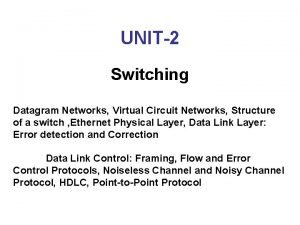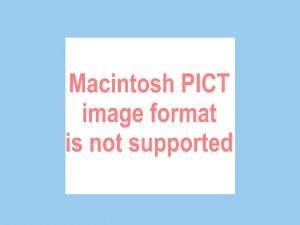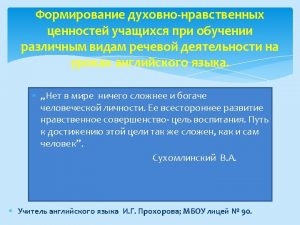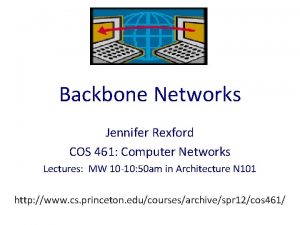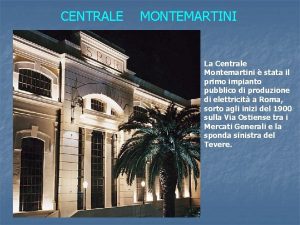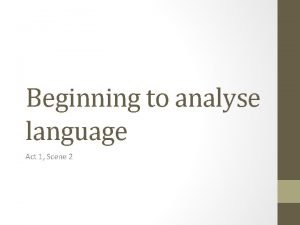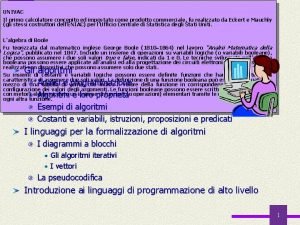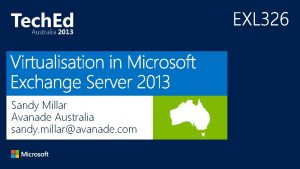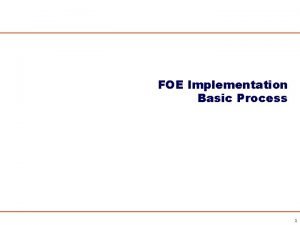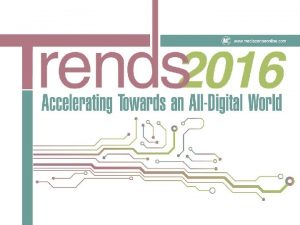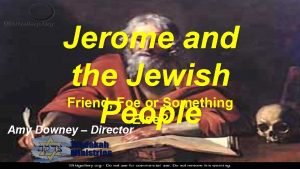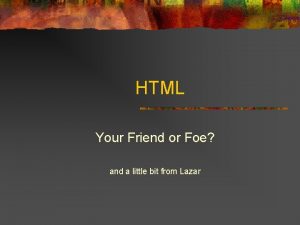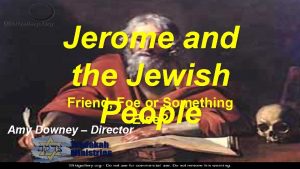AllDigital Networks Friend or Foe Sandy Teger and














- Slides: 14

All-Digital Networks: Friend or Foe? Sandy Teger and David Waks Co-Founders, Broadband Home Central They're Just Over the Horizon: Emerging Technologies, Friend or Foe? Broadband. Plus: December 5, 2002 Copyright © 2002

Our Bottom Line • All-digital converged networks will become the norm • Could be “friend” if MSOs adapted HFC – Could carry much more content in much less bandwidth – New converged service opportunities additional revenue – Standards low costs – Positive positioning with emerging public “broadband” policy • Foe if MSOs don’t move in an orderly and timely way – FTTH-based “community networks” may fill the vacuum – Lost MSO customers – Stranded costs • This talk focuses on using a single infrastructure – Doesn’t consider combinations such as DBS/DSL Copyright © 2002 Slide 2

About Us • Dave – Founder and R&D director, Prodigy Services Company • Sandy – 18+ years with AT&T; multimedia strategy director • As System Dynamics – Consulting in broadband to service and technology providers – Technology, marketing and business analysis and planning – Projects have included cable modem rollout, VOD, interactive TV, digital cable, HFC and IP telephony – Industry analysts - website, newsletter • As Broadband Home Central – Industry resource focused on residential broadband – Includes whole ecosystem, both TO and IN the home – Free monthly report goes to 100+ countries – Broadband Home Labs does real world in-home testing – www. Broadband. Home. Central. com Copyright © 2002 Slide 3

“All-Digital Networks” – What Do People Mean? • All services carried in digital formats – Digital data – Digital voice – Digital television • Usually all services carried over IP – Data – Voice over IP – Video over IP – unicast and multicast • Usually all services carried over Ethernet – Gigabit Ethernet – 10 Gigabit Ethernet • Usually all services carried over fiber – Active or passive optical networks Copyright © 2002 Slide 4

Why Build “All-Digital” Networks? • Everything is going digital – Internet applications, of course! – Packaged media: CDs, DVDs – Self-recorded media: MP 3 s, PVRs – Digital cameras and camcorders – IP telephony • Lower cost than mixed analog and digital – Both network and CPE • Analog broadcast TV is coming to an end – Not 2006, but probably this decade • Will analog cable TV also come to an end? Copyright © 2002 Slide 5

Everything Is Going Digital 1992 2002 2012 Audio Players Video Players Still Cameras Camcorders Satellite TV Cable TV ? Broadcast TV Telephone New CE Copyright © 2002 Slide 6

All-Digital Example: Fast. Web In Italy • Fiber to every building – business and residential • Providing both dark fiber and integrated services • Gigabit Ethernet over fiber to Ethernet switch in basement • 100 Mbps over fiber to each apartment • All IP based digital services – High speed Internet at 10 Mbps symmetric – IP telephony: flat rate to all of Italy – IP television: full TV lineup, video on demand – Networked PVR – CD pay per play – TV-based videocommunications service • Rolling out in Milan, Rome, Genoa, Turin, Bologna • More than 100, 000 paying subscribers Copyright © 2002 Slide 7

FTTH “Community Networks” Growing in U. S. • Areas unserved or “underserved” by incumbents – Communities feel scalable broadband infrastructure critical for survival and growth – Incumbents don’t see economic justification for additional investment • Local governments – Revitalize & grow the local economy – Infrastructure needed to attract and retain residents and businesses – FTTH increasingly attractive as costs come down – Funded by long-term bonds – Selling points: Educational opportunities, keep kids in community – Provide customer choice often as wholesale provider • Public power utilities facilitate implementation – See broadband as fundamental as power and water – Leverage existing rights of way and service infrastructure Copyright © 2002 Slide 8

Where Are “Community Networks” Happening? • Unserved areas – Mostly rural, low population density – Low priority for MSOs and telcos – Examples: Grant County and Mason County, Washington • Competitive communities – Mostly high-tech suburbs – Universities and schools – High-tech businesses – Some unserved, others see themselves as “underserved” by incumbents – See “real” broadband as competitive differentiation – Example: Palo Alto trial, many others in development Copyright © 2002 Slide 9

UTOPIA Example • The Utah Telecommunication Open Infrastructure Agency – 17 cities working collectively as ”interlocal” cooperative entity – Total Population: 542, 190 (~25% of Utah) – Can issue bonds and share revenues same as member cities • Project Goals – Increase quality of life more & varied high quality services at competitive prices – Promote economic development – Serve every home and business within member cities – No taxpayer subsidy • Current Status – Planning to implement FTTH to all cities – Finance with “limited obligation” bonds: 15 -20 year cost recovery – “Open Service Provider Network” – wholesale transport services – Will sell access to retail providers of voice, video and data services – Issue bonds and start construction in 2003 Copyright © 2002 Slide 10

Are Community Networks “All-Digital”? • Vendors promoting all-digital FTTH – IP for all video • Community networks may not all start all-digital – Huge overhang of analog TVs and VCRs – Need to provide IP set-top box for each TV and VCR – Some communities choosing FTTH with analog overlay on digital services • Will be all-digital soon – Cost of IP set-top boxes coming down with volume – Centralized set-top could move functionality to one device, including digital-to-analog conversion – Home networking will allow digital video distribution to remote TVs Copyright © 2002 Slide 11

Where’s Cable in Digital? • HFC plant optimized for broadcast analog TV – 6 MHz channelization – “Low-split” configuration highly asymmetric • Supports digital services as incremental “add-on” – Digital video, voice and data all operate in 6 MHz TV channels – MPEG transport optimized for video rather than integrated services – Suboptimal with increasing interactivity • Major innovations for extending cable bandwidth – DOCSIS 2. 0 – Narad Networks, Xtend Networks, Pulse~LINK, … – All assume continuation of current plant structure Copyright © 2002 Slide 12

Threats and Opportunities • What’s the threat? – “It’s only Grant County, Washington” Utah” college towns” suburbs of Chicago and Boston” – Is FTTH today like DBS ten years ago? • What’s the opportunity? – Leverage HFC infrastructure for “all-digital” applications – Leverage technologies not developed directly for cable – Loosen the grip of traditional players – eg, for conditional access – Reduce cost structure in plant and CPE – Innovative new services additional revenue • Questions for MSOs – Can existing HFC infrastructure compete with FTTH? – If so, what changes are required in analog, low-split, MPEG transport? – When to start transition? – Are deployment decisions made today on the right path? Copyright © 2002 Slide 13

Questions? www. broadbandhomecentral. com dave @ bb-home. com sandy @ bb-home. com www. broadbandgurus. com 18 Beaver Ridge Road, Morris Plains, NJ 07950 -1901 (973) 644 -4739 Fax (973) 538 -6003
 Hello the sun is shining
Hello the sun is shining Hello my friend!
Hello my friend! Friend or foe game show
Friend or foe game show Friend or foe chapter 2
Friend or foe chapter 2 Friend or foe station lab answers
Friend or foe station lab answers Example of virtual circuit network
Example of virtual circuit network Let's be good friends you and i
Let's be good friends you and i Foaf friend of a friend
Foaf friend of a friend A friend in needs a friend indeed
A friend in needs a friend indeed I've found a friend oh such a friend
I've found a friend oh such a friend Backbone networks in computer networks
Backbone networks in computer networks Statua di zeus foe
Statua di zeus foe As cannons overcharged with double cracks meaning
As cannons overcharged with double cracks meaning Calcolatore foe
Calcolatore foe The birth of shaka zulu poem
The birth of shaka zulu poem





